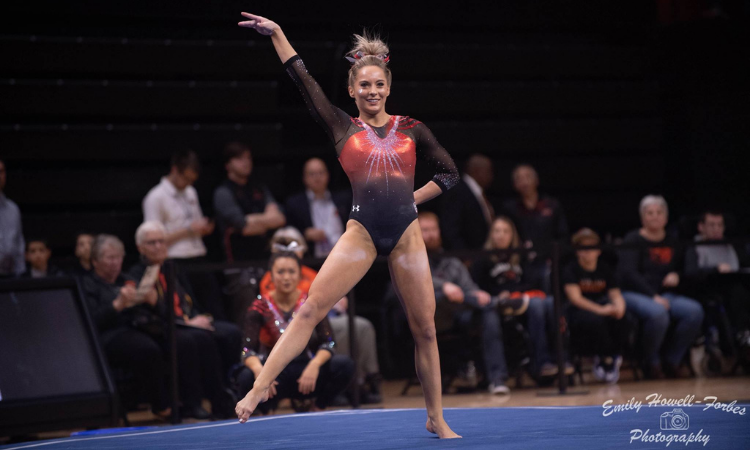Are you a full-time college gymnastics fan but a part-time elite gymnastics watcher? Still not sure which college stars to tune in to see in Tokyo? With women’s gymnastics at the Olympic Games kicking off this evening, we have your breaking of which NCAA gymnasts are vying for Olympic glory and the differences between college and elite gymnastics.
The Basics
Olympic artistic gymnastics will take place in Tokyo this year from July 23 to Aug. 3 at the Ariake Gymnastics Center. The women will compete for medals in the team, individual all around, vault, uneven bars, balance beam and floor exercise with the men vying for medals in the team, individual all around, floor exercise, pommel horse, still rings, vault, parallel bars and high bar.
For a breakdown of the Olympic Games gymnastics schedule, check out our detailed viewers guide for all the important details.
How the Competition Works
All gymnasts and teams will compete in the qualifications sessions in an attempt to qualify for the team, individual all around and event finals. The top eight teams qualify for the team finals. The top 24 gymnasts in the all around standings qualify for the all around final and the top eight in each event’s standings will qualify for their respective event finals. However, only the top two gymnasts per country are allowed to qualify for the all around and event finals, so if a gymnast places high enough to qualify for the final but has been beaten by two of their teammates, they will not advance to the final and the next gymnast in the standings will qualify instead. This is the infamous “two per country” rule.
College Gymnasts in Tokyo
When does [insert favorite college gymnast here] compete so I know when to watch?
Don’t get too excited; the vast majority of collegiate gymnasts don’t currently compete at the elite level and thus weren’t even considered for the Olympics. However, 11 former, current or future NCAA competitors will be there. Six athletes are future NCAA gymnasts, two have already completed their collegiate career and three are currently in college.
- Jade Carey (Oregon State ‘25)
- Jordan Chiles (UCLA ‘25)
- Danusia Francis (UCLA ‘16)
- Sunisa Lee (Auburn ‘25)
- Grace McCallum (Utah ‘25)
- Brooklyn Moors (UCLA ‘25)
- Amelie Morgan (Utah ‘26*)
- Shallon Olsen (Alabama ‘22)
- Ariana Orrego (Iowa State ‘22)
- MyKayla Skinner (Utah ‘19)
- Tan Sze En (Stanford ‘24)
Check out our NCAA Gymnastics at the Tokyo Olympics preview for a full breakdown of all the gymnasts representing NCAA programs at the Olympics.
*Amelie Morgan has not officially committed to Utah, but lists the school on her Instagram profile biography. Her official grad class is also unknown, but she is expected to be a member of the class of 2022.
When Do the NCAA Gymnasts Compete?
Spread out across five subdivisions, most competitors will be attempting to qualify for finals at different times.
If you’re following Alabama, you’ll be able to watch Shallon Olsen on July 25 at 4:05 a.m. EST, she’s set to compete in subdivision 4. Likewise, fellow Canadian national teammate Brooklyn Moors, who is bound for UCLA, will be competing then as well. The remaining Bruins, Jordan Chiles and alumna Danusia Francis, will both be competing on July 25 at 2:10 a.m. EST in subdivision 3, representing the United States and Jamaica, respectively.
Also competing in subdivision 3 you’ll find current Cyclone, Ariana Orrego, who will be representing Peru as well as Oregon State’s Jade Carey, Auburn’s Sunisa Lee, Utah’s Grace McCallum and former Ute gymnast Mykayla Skinner, all representing the United States.
Amelie Morgan, a future Ute, will be representing Great Britain and competing on July 24 at 10:55 p.m. EST in subdivision 2 while current Stanford gymnast Tan Sze En will be representing Singapore in the first subdivision on July 24 at 9 p.m. EST.
For those that qualify with their team, they’ll be due to compete on July 27 at 6:45 a.m. EST in the team final. Should any qualify within the top 24 for the all around, they’ll compete July 29 at 6:50 a.m. EST. For those that qualify as a top eight individual in an event, they’ll expect to compete in the vault and bars final Aug. 1 at 4 a.m. EST, the floor final on Aug. 2 at 4 a.m. EST and conclude with the beam final on Aug. 3 at 4 a.m. EST.
How Can They Do Both?
There are no rules barring collegiate gymnasts from competing internationally for their respective countries, so these athletes are allowed to compete at the Olympics if they are selected by their national team to do so. However, this is rare, as it is difficult to be competitive internationally while competing collegiate level routines because they are generally “easier” to maximize scores in the 10.0 system. Gymnasts who compete internationally during their collegiate careers generally train harder skills in addition to what they perform in their college routines and/or just compete with their added difficulty in their college routines.
Differences Between College and Elite Gymnastics
What’s the Difference Between College and Elite Gymnastics?
Elite gymnasts compete to make their respective national teams and qualify for international assignments, such as the world championships and the Olympics. Elite gymnastics is also more focused on the individual rather than the team, with many countries’ national championships only awarding individual titles and no team awards. Team competitions are held at Olympic Games and most world championships, where gymnasts are representing their respective countries as a team.
How Does the Gymnastics I’ll See at the Olympics Compare With the Gymnastics I watch at an NCAA Meet?
College gymnastics uses the 10.000 scoring system. This scoring system rewards execution, so you’ll see gymnasts perform (comparatively) easier skills and routines to focus on perfection.
Elite gymnastics rewards execution and difficulty through two different scores. The execution score goes up to a 10.0, but the difficulty score has no such boundary since it depends on the combination of elements in the gymnast’s routine. An elite gymnast’s total score on an event is determined by combining their execution and difficulty scores together.
- Example: If a gymnast performs a vault with a difficulty value of 5.0 for an execution score of 9.200, the gymnast’s vault score would be a 14.200.
History of College Gymnasts at the Olympics
The College Gymnastics Pipeline at Olympics
Gymnasts with NCAA connections have been competing in the Olympics since at least 1984 when Stanford commit Nancy Goldsmith represented Israel at the Games and went on to compete for the Cardinal the next year. Since 1984, 65 NCAA gymnasts have competed in the Olympics, not including the 11 NCAA-associated athletes that will be competing in Tokyo this year. With each passing quad, more gymnasts opt for this path, several doing so during their time in college, including Jessica Lopez who did so while competing for Denver and after graduating, and Toni-Ann Williams who was with California. In Tokyo, Shallon Olsen, Ariana Orrego and Tan Sze En will be following in their footsteps as they continue to train elite while in college.
Others have chosen to continue their elite career after college, pursuing their Olympic dreams after graduating, most notably UCLA alumnae Mohini Bhardwaj and Danusia Francis. Over the years, UCLA has amassed 20 female Olympic gymnasts, past and present. After the Tokyo Olympics, this number will bump to 22. Only Stanford comes close over the years with nine NCAA gymnasts competing in the Games, with the number rounding to 10 following Tokyo. Utah will surpass Georgia with six athletes and Auburn gymnastics will be represented for the first time in an Olympic Games by Sunisa Lee.
READ THIS NEXT: CGN Roundtable: Olympians and the NCAA
Article by Allison Freeman, Brandis Heffner and Katherine Weaver
Like what you see? Consider donating to support our efforts throughout the year! [wpedon id=”13158″]





No talk about Oklahoma joining the SEC??
That wouldn’t really be appropriate in this article, and it’s information that’s not yet official either. We’ll report on it once/if it is confirmed. Thanks for reading though!
Yeah sorry didn’t mean it for this article. Haha! Just in general and waiting to report on something that is in the works and such a huge deal in collegiate gymnastics later is interesting on your part, but I do appreciate the response back.